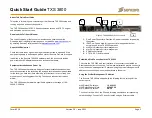
27
57-642 ECLIPSE Model 705 Guided Wave Radar Transmitter for Hygienic Industries
ETS is accomplished by scanning the waveguide to collect
thousands of samples. Approximately 8 scans are taken per
second; each scan gathers more than 30,000 samples.
4.0
Initial Start-Up
The introduction of Guided Wave Radar (GWR) technolo-
gy as a method to measure level, increases performance and
provides unique solutions beyond traditional level measure-
ment methods. GWR devices have been successfully
applied in the Life Sciences industry for more than a
decade. There are thousands of units installed in all facets
of production as well as in the utilities section of these facil-
ities. (Please refer to the Industrial I/O manual 57-606 for
additional information on non-hygienic applications.)
Based on that extensive experience, this document provides
some suggested best practices for the installation and start-
up of GWR devices commonly found in the Life Sciences
industry.
4.1 Probe Location
The primary consideration for a new GWR installation is
the location of the wave guide or probe. In comparison to
other radar technologies, GWR is extremely robust and is
not easily affected by typical disturbances within a vessel.
However, there are opportunities to capitalize on a few best
practices to reduce, if not eliminate, fine tuning at installa-
tion.
The best location for a guided wave radar unit is along the
outer belt ring. Position the probe away from baffles, dip-
tubes, and any agitation device that might damage the
probe. While not imperative, the selected position for the
probe should be as far as possible from spray bulbs to sim-
plify installation, start-up, and commissioning of the
device. Conversely, the distance between the probe and a
vortex breaker or drain can be as close as 1 inch (2.5 cm).
The best location for a Guided Wave Radar probe is on the
top head of a vessel, as close the sidewall as possible. The
nozzle and probe should be marked to identify the correct
orientation within the tank.
The orientation is critical to
the performance of the installation.
Deviation from the
correct orientation can change the characteristic non-linear-
ity of the probe and therefore reduce measurement repeata-
bility. The methods for correction are all reliant on the
repeatability of the device. Therefore, if there is any con-
cern regarding the probe’s movement, an alignment hook
















































